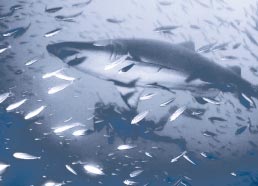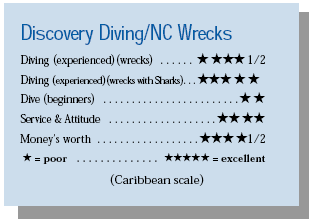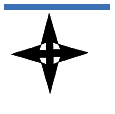Where In the World is Carmen San Diego?Contents of this Issue: Where In the World is Carmen San Diego? When Your Guide Is Asleep At The Wheel Editorial Office: Ben Davison Publisher and Editor Undercurrent 3020 Bridgeway, Suite 102 Sausalito, CA 94965 . . . when she's shark diving with WWII wrecks from the September, 2000 issue of Undercurrent
Dear Fellow Diver: Where in the world is Carmen San Diego, if she is in the middle of a massive baitball of shimmering silversides, with huge schools of spadefish pushing at the edges, amberjacks and barracuda hunting in the mix, seven-foot gnarly-toothed sharks meandering through, with an even larger hammerhead coming in? Where in the world is Carmen San Diego, if the July surface temperature is 78 degrees, visibility hits 75 feet on scores of American ships in this WWII graveyard ... and she returns to sleep on land at night, after a $75 two-tank dive? Palau, you say? The Solomon Islands? Papua New Guinea’s Bismark Sea? There goes the buzzer. You lose ... unless, that is, you said off the coast of North Carolina, in the middle of the Gulf Stream. Yup, big fish diving right here in the good old U-S of A. You see, during WWII, the Americans and Germans staged a secret yet massive naval war off the Atlantic Coast. In the first eight months of 1942, German U-boats attacked nearly 300 vessels, sinking most of them, while we nailed only seven German subs. North Carolina’s Graveyard of the Atlantic, from Nags Head in the north to Wilmington in the south, is the tomb of thousands of downed ships, thanks not only to WWII, but also to shallow shoals, centuries of buccaneers, reckless captains, and now artificial reefs. Since the first U-boat was discovered in 1976, a major dive industry has emerged. In July, I (but without Carmen San Diego, who had continuing obligations with the PBS kids show) headed to the Morehead City/Beaufort area, from where a half dozen operators base six-packs to crew boats. Some depart daily, others only on weekends. You bring or rent tanks — some people dive double 72’s — and weights and carry onboard an ice chest -- it might be your seat -- with food and beverages. After the dive, you tote everything home and repeat it the next day. The two big players here are Discovery Diving in Beaufort and Olympus Diving in Morehead City. George Purifoy, the owner of Olympus, has discovered many wrecks. His dive shop proudly displays a brass plaque from the Proteus, and the deck gun and binnacle from the U-352. His flagships, the 65-foot Olympus and the 48-foot Midnight Express, carry 25 and 18 passengers respectively. He also exclusively charters a couple of smaller boats owned by others. I chose Discovery Diving simply because I could get a space (be forewarned:
reserve early; boats fill early in the summer diving season). During five days of two-tank diving, I hit seven of more than two dozen popular wrecks, which are mostly covered with barnacles and filamentous algae, giving them a fuzzy/crusty appearance. On a typical day in a crew boat, we motored through choppy seas, covering 20+ miles to the Gulf Stream in two hours. About a mile out of the Beaufort inlet, a white buoy marks the final resting place of Blackbeard’s flagship, the Queen Ann’s Revenge. We can’t dive it since the state controls access to this historic vessel and meters out research permits. Farther out, bottlenose dolphins leapt in the wake and an occasional turtle grazed the sheets of floating Sargassum weed. After two dives, we’d return about 3 p.m. The faster six-packs return as early as 1:30 p.m., cutting at least an hour off the round trip. With Leroy Craytor, I visited the Atlas, a 430-foot American oil tanker torpedoed by the German sub U-552 at 3 a.m. on April 9, 1942. Upright, but in three pieces, the Atlas sits at 130 feet. The Captain hooked the vessel and the mate dived to secure the anchor. After a backward roll, I kicked down to the anchor line. Not much current and 50-foot visibility. At 40 feet, I strained to see the top decks at 90 feet. Gradually, I could make out the swirling movement of a dense cloud of baitfish and the first shadows of the Sand Tigers swimming lazily through this delicate ballet of silversides. Entering a baitball surrounding the stern, I found myself cruising with scores of 6- to 8-foot Sand Tigers, bristling with the world’s ugliest dentition. Strobes flashed as photographers fired their next wall hanger. Leaving the top deck, I dropped through a 20-foot hole and descended through the decks to the hull bottom at 125 feet. There I scared a pair of seven footers who rocketed out, scaring the bejesus out of two buddies idly swimming above. A brief 30 minutes later, I started my ascent with one roll in the can, a three minute deco obligation, and amazement at the fish life I’d seen. As I ascended, Atlantic spadefish, amberjacks and barracuda savaged the bait ball. And not a shot left for the big hammerhead that came to visit. The signature dive here, U-352, sits at 115 fsw, listing 40 degrees to starboard.
Visibility was the best I had — 80 feet. My spooky feeling about this WWII enemy
sub was amplified when a 3-foot Dorado sliced through huge schools of silversides
surrounding the vessel. A 412-foot long oil tanker, the Papoose, landed upside down in 130 fsw on March 3, 1942, a victim of the German sub U-124. With visibility down to 30 feet and the much publicized sand tiger sharks absent, save one solitary soul cruising the companion ways, this dive disappointed. The wreck was barren of schooling fish. Another day, we tried the Portland, picked by the Captain who wanted to check the visibility on an often easy shallow dive right off the shoals. We found a broken-up 289-foot Panamanian freighter in 55 fsw presenting us with 25-feet visibility that rapidly dropped to 15 feet. While buddy groups were getting lost, I ran a wreck reel to navigate. I ran across two Sand Tigers and a large scorpionfish, but pictures were out of the question. About penetration. I have cave diver training and use a Dive Rite reel with 400 feet of line. While light filtered through enormous, easily negotiable holes on many wrecks, when visibility got low — sometimes 15 feet — the reel was helpful. Few divers used reels, but the low visibility intimidated some. So, they hung close to the anchor line, followed obvious courses back and forth — and even followed my line. Diving here isn’t for newbies, though experienced open-water divers do just fine. NC dive operators treat their divers like big boys and girls. They provide a trip to the wreck, a brief history, lay out, and suggest a dive plan. And that’s that. No one asks specifics about your dive profile. No one guides. It’s just you and, presumably, your buddy. You can penetrate wrecks, spear fish, and make deco dives. Surface conditions and visibility — especially above and below the thermoclines — may change day to day, site to site, even during your dive. Currents can be strong, and seas are often rough. And up top you may step over seasick divers blowing chunks. It’s up to you to ensure that your skills, equipment and stomach are up to the demands. During my stay, I requested dives four times on Caribsea, a 251-foot American freighter torpedoed in 1942 that lies at a comfortable 90-foot depth. Although the visibility fluctuated between 50 feet above the thermocline and 15 feet on the 90-foot bottom, the site was a veritable soup of sea life. One dive found us barely leaving the anchor line because the sharks were so thick. While I’d usually run my line to a prominent spire sticking off the bow, here I hung above the thermocline and marveled at wave after wave of sharks cruising endlessly around the wreck. Schools of jacks and spadefish appeared mysteriously out of the gloom. Grouper and snapper huddled in the hull. Forty mature barracuda, stacked like cordwood, cruised close during my safety stops. Giant schools of baitfish blocked out both my buddy and the sun. The Caribsea was Sand Tiger central. A word about Atlantic sand tiger sharks. Undisturbed by diver bubbles or close approaches, these docile critters allow photo ops that are truly up close and personal. Juveniles, which are covered in brown spots, are so curious you may need to push them off your camera lens to get a shot. But, the crew confirmed cases of spearfishers who were hit when refusing to part with their catch. Now most spearfishermen cool their heels if sharks are thick. After dark, diving is prohibited. Back on terra firma, one has plenty of options for night time bedding. Both Olympus and Discovery have inexpensive bunk house accommodations for groups. I set up house at the low budget Morehead Motor Lodge, about a ten-minute ride from either operation. $43 a night bought my buddy and me a small room with two firm beds, peeling paint but plenty of hot water, a TV without remote, A/C, and a shower with a sluggish drain. Not the place to take the wife and kids, but perfect for two guys. For the family, consider the Sheraton or the Sand Oceanfront Resort at nearby Atlantic Beach; couples may find the local bed and breakfast inns their cup of tea. If the weather keeps you off the water — hurricanes come this way, you know — the Beaufort/Morehead City area has other attractions. Atlantic Beach has an amusement park and the usual assortment of tacky surf shops. The North Carolina Aquarium at Pine Knoll Shores is worth a half-day tour. Fort Macon State Park boasts an excellent Civil War brick fort complete with ramparts and cavernous arched roofed rooms, along with a fine stretch of undeveloped beach. Restaurants tout their 90-foot buffets, but I found their food to be much too greasy, too fried, and sometimes too cold. My favorite meals were prepared by the Crab’s Claw, a second floor waterfront walk up on Atlantic Beach that specialized in an eclectic mix of seafood and steaks and served up crabmeat dip appetizers and fresh bread with garlic oil. So, there you have it, big fish action without the big bucks, the long flights, the two-week commitment. All that’s required are some good diving skills, a little courage and a strong stomach. - P. K.
Discovery only supplies air but Olympus and the Wreckreational Dive Center in Atlantic Beach both pump Nitrox and rent tanks to divers using other operators. Discovery Diving offers a five night bunk-house package with four days of diving for $349 (Sunday check-in only), ... Morehead Motor Inn (252) 726-5141; (from $39+ tax/rm/nt to $72/nt weekends) mention diver’s discount when booking. Discovery Diving: www.discoverydiving.com (252) 728-2265 (four boats). Olympus Diving: www.olympusdiving.com (800) 992-1258 or (252) 726-9432 (4 boats). Pelican Divers: www.diveguide.com/p0408 (800) 488-4220 (45’-18 passenger). Diver Down: www.diverdownscubadiving.com (757) 426-8410 ( 42’-18 passenger). Atlantis Diving Co: www.charternet.com/charters/atlantis (252) 728-6244 (46’-6 pack). Diveocean: www.divocean-dive-center.com (252) 726-3575 (40’ -6 pack). Wreckreational Dive Center: (252) 240-2244 (Nitrox, tanks, & technical gear). Lots of other NC dive links at: www.nc-wreckdiving.com and www.ncscuba.com |

I want to get all the stories! Tell me how I can become an Undercurrent Online Member and get online access to all the articles of Undercurrent as well as thousands of first hand reports on dive operations world-wide
| Home | Online Members Area | My Account |
Login
|
Join
|
| Travel Index |
Dive Resort & Liveaboard Reviews
|
Featured Reports
|
Recent
Issues
|
Back Issues
|
|
Dive Gear
Index
|
Health/Safety Index
|
Environment & Misc.
Index
|
Seasonal Planner
|
Blogs
|
Free Articles
|
Book Picks
|
News
|
|
Special Offers
|
RSS
|
FAQ
|
About Us
|
Contact Us
|
Links
|
3020 Bridgeway, Ste 102, Sausalito, Ca 94965
All rights reserved.

 Several craft depart
Discovery’s docks on the weekends, fewer during the week. Usually one big boat leaves
at 7:30 a.m., along with morning and
evening six-pack trips. I dove with
three of his charter captains. Terry
Leonard, with the 47-foot steelhulled
crew boat Outrageous V, and
Jerry Smith, who pilots the similar
Seaquest II, run professional trips.
On Seaquest, we had 7 of 16 spots
filled. On Outrageous, 11 out of 20.
The big boats offer more room, freshwater,
and a more stable journey. Yet
my favorite vessel turned out to be
Leroy Craytor’s 35-foot funky sixpack,
Captain’s Lady. Its shallow
draft and fast sprint across the
shoals, his willingness to run with
as few as four divers, and his “can
do” attitude one morning by waiting
out bad weather to run his two-tank trip in the afternoon, certainly got my attention,
as well as my loyalty.
Several craft depart
Discovery’s docks on the weekends, fewer during the week. Usually one big boat leaves
at 7:30 a.m., along with morning and
evening six-pack trips. I dove with
three of his charter captains. Terry
Leonard, with the 47-foot steelhulled
crew boat Outrageous V, and
Jerry Smith, who pilots the similar
Seaquest II, run professional trips.
On Seaquest, we had 7 of 16 spots
filled. On Outrageous, 11 out of 20.
The big boats offer more room, freshwater,
and a more stable journey. Yet
my favorite vessel turned out to be
Leroy Craytor’s 35-foot funky sixpack,
Captain’s Lady. Its shallow
draft and fast sprint across the
shoals, his willingness to run with
as few as four divers, and his “can
do” attitude one morning by waiting
out bad weather to run his two-tank trip in the afternoon, certainly got my attention,
as well as my loyalty.  While penetration is possible, I backed out of a tiny hatchway
in the conning tower, after stirring up a
thick cloud of silt. Visits to the
Aeolus, a 400+ foot cable layer, and the
Indra, a 316-foot US landing craft repair
ship, both sunk as artificial reefs,
offered easy penetrations stem-to-stern,
though the Aeolus has been broken into
three pieces by hurricanes. Along
encrusted structures, large amberjacks
provided fine photo ops.
While penetration is possible, I backed out of a tiny hatchway
in the conning tower, after stirring up a
thick cloud of silt. Visits to the
Aeolus, a 400+ foot cable layer, and the
Indra, a 316-foot US landing craft repair
ship, both sunk as artificial reefs,
offered easy penetrations stem-to-stern,
though the Aeolus has been broken into
three pieces by hurricanes. Along
encrusted structures, large amberjacks
provided fine photo ops.  Diver’s Compass: The closest major airport in Raleigh/Durham is 3.5
hours away; some people use Myrtle Beach, S.C. ... the all day twotank
trip to the better offshore wrecks runs $75; two-tank inshore wreck trips run $45 (depth and visibility reduced). Three-tank trips by arrangement.
Bring your own food or snacks; most big boats have drinking water, six-packs may not.
Accommodations for cameras relative to the size of the vessel ... the shops are all full
service with plenty of rental gear, including wet suits.
Diver’s Compass: The closest major airport in Raleigh/Durham is 3.5
hours away; some people use Myrtle Beach, S.C. ... the all day twotank
trip to the better offshore wrecks runs $75; two-tank inshore wreck trips run $45 (depth and visibility reduced). Three-tank trips by arrangement.
Bring your own food or snacks; most big boats have drinking water, six-packs may not.
Accommodations for cameras relative to the size of the vessel ... the shops are all full
service with plenty of rental gear, including wet suits.